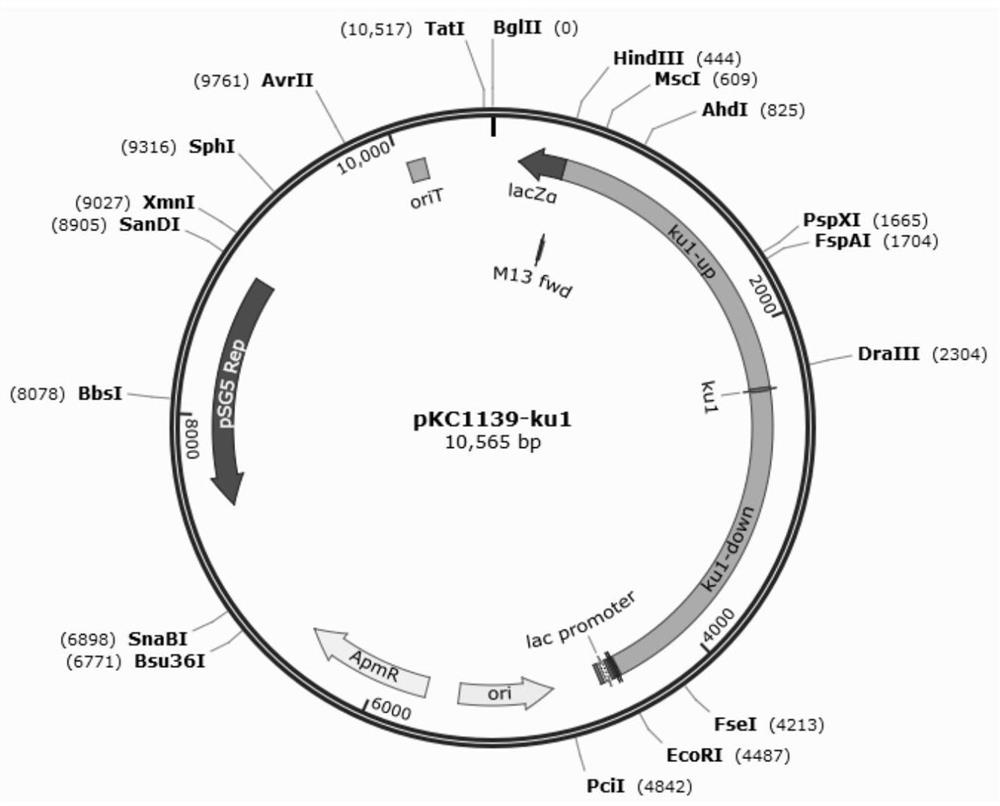High efficient homologous recombination engineering strain of Amycobacter, its construction method and application
A mycobacteria pseudomycoides and engineering strain technology, which is applied in the field of highly efficient homologous recombination and efficient Amycobacter pseudomycoides engineering strains, and can solve the problems of low homologous recombination efficiency, restricting the application of gene targeting technology and the like
- Summary
- Abstract
- Description
- Claims
- Application Information
AI Technical Summary
Problems solved by technology
Method used
Image
Examples
Embodiment 1
[0057] Example 1: Construction of ku1 gene deletion strain
[0058] The sequence of ku1 of Amycolatopsis is compared on the NCBI website according to the gene sequence of Amycolatopsis sp.ATCC 39116 strain, the gene sequence is as shown in SEQ ID NO: 1, and the encoded protein accession number is WP_027936589.1.
[0059] Construction of ku1 gene deletion strains: In order to knock out the ku1 gene in Amycobacterium pseudomycoides, ku1-U-FOR / ku1-U-REV and ku1-D-FOR / ku1-D-REV were used as primers, respectively. Amycobacter HM-141 genome was used as template, and the upstream and downstream homology arms of ku1 gene were amplified by PCR. At the same time, the above two ku1-up and ku1-down fragments were connected to the HindIII / EcoRI site of the pKC1139 plasmid by the Assembly kit to complete the construction of the plasmid pKC1139-ku1. The plasmid map of pKC1139-ku1 is as follows figure 1 shown.
[0060] The pKC1139-ku1 plasmid was transformed into Amycobacterium pseudomycoi...
Embodiment 2
[0061] Example 2: Construction of ku2 gene deletion strain
[0062] Similarly, the sequence of ku2 in the Amycobacterium pseudomycetes strain was aligned on the NCBI website according to the gene sequence of the Amycobacterium pseudomycoides ATCC 39116 strain, and the encoded protein accession number was WP_020416491.1.
[0063] Construction of ku2 gene deletion strains: In order to knock out the ku2 gene in Amycobacterium pseudomycoides, ku2-U-FOR / ku2-U-REV and ku2-D-FOR / ku2-D-REV were used as primers, respectively. The genome of Mycobacterium HM-141 was used as the template, and the upstream and downstream homology arms of the ku2 gene each about 2 kb were amplified by PCR.
[0064] The above two ku2-up and ku2-down fragments were connected to the HindIII / EcoRI site of the pKC1139 plasmid by the Assembly kit to complete the construction of the plasmid pKC1139-ku2. The plasmid map of pKC1139-ku2 is shown in figure 2 shown. The pKC1139-ku2 plasmid was transformed into Amyco...
Embodiment 3
[0065] Example 3: Construction of strains with both ku1 and ku2 genes deleted
[0066] On the basis of the Δku1 strain constructed in Example 1, the ku2 gene was further knocked out:
[0067] The pKC1139-ku2 plasmid of Example 2 was transformed into the Δku1 strain using the conjugation transfer experiment method, and positive mutants were screened according to abramycin resistance to obtain a genetically engineered strain Δku1ku2 with both ku1 and ku2 genes deleted.
PUM
 Login to View More
Login to View More Abstract
Description
Claims
Application Information
 Login to View More
Login to View More - R&D
- Intellectual Property
- Life Sciences
- Materials
- Tech Scout
- Unparalleled Data Quality
- Higher Quality Content
- 60% Fewer Hallucinations
Browse by: Latest US Patents, China's latest patents, Technical Efficacy Thesaurus, Application Domain, Technology Topic, Popular Technical Reports.
© 2025 PatSnap. All rights reserved.Legal|Privacy policy|Modern Slavery Act Transparency Statement|Sitemap|About US| Contact US: help@patsnap.com



